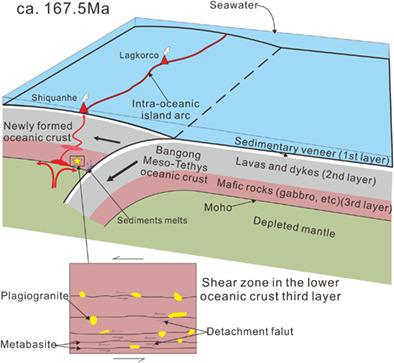当前位置:
X-MOL 学术
›
Geolog. J.
›
论文详情
Our official English website, www.x-mol.net, welcomes your feedback! (Note: you will need to create a separate account there.)
An island arc origin of Jurassic plagiogranite in the Shiquanhe ophiolite, western Bangong Suture, Tibet: Zircon U–Pb chronology, geochemistry, and tectonic implications of Bangong Meso-Tethys
Geological Journal ( IF 1.8 ) Pub Date : 2021-04-11 , DOI: 10.1002/gj.4137 Wei Li 1, 2 , Nina Liu 2 , Ranjit Nayak 3 , Yaoliang Ma 1, 2, 4, 5, 6 , Jinjun Wang 7 , Xichong Hu 1, 8 , Jiehui Pang 1, 2, 4, 5, 6 , Weile Huang 1, 2, 4, 5, 6 , Yun Zhong 1, 2, 4, 5, 6 , Weiliang Liu 1, 2, 4, 5, 6
Geological Journal ( IF 1.8 ) Pub Date : 2021-04-11 , DOI: 10.1002/gj.4137 Wei Li 1, 2 , Nina Liu 2 , Ranjit Nayak 3 , Yaoliang Ma 1, 2, 4, 5, 6 , Jinjun Wang 7 , Xichong Hu 1, 8 , Jiehui Pang 1, 2, 4, 5, 6 , Weile Huang 1, 2, 4, 5, 6 , Yun Zhong 1, 2, 4, 5, 6 , Weiliang Liu 1, 2, 4, 5, 6
Affiliation

|
The plagiogranites in ophiolites are minor in volume but can provide crucial information for the origin and tectonic evolution of ancient oceanic lithosphere. This paper presents the geochronology and geochemistry of a newly discovered plagiogranite in the Shiquanhe ophiolite, from the west end of the Shiquanhe-Jiali ophiolite sub-belt, Bangong Suture, central Tibet. Zircon U–Pb dating of two samples yields Middle Jurassic ages (167.4 ± 1.2 Ma and 167.5 ± 1.5 Ma). The plagiogranite has positive whole-rock εNd(t) (4.2–4.9) and zircon εHf(t) (9.6–14.3) values, high Th/Nb ratios (0.6–2.8) but relatively low La/Nb ratios (0.9–9.9), indicating that it was possibly derived from a depleted mantle with the contribution of minor subducted sediments. The LREE-enrichment but HREE-flat patterns with negative Eu anomalies and negative Nb-Ti anomalies resemble those of shear-type plagiogranites, which mean that this rock was likely formed by partial melting of metabasite. Combined with the plagiogranite which does not exhibit chilled contacts against the Shiquanhe ophiolitic metabasite, suggests that the plagiogranite may have been derived from the associated ophiolitic metabasite. Geochemical calculating and modelling indicate that the plagiogranite was possibly produced by a low degree (<10%) partial melting of metabasite and replenished by minor sediments melts at low temperature (<800 °C) and low pressure (<0.1 GPa) conditions. The Shiquanhe plagiogranite, together with the contemporaneous Lagkorco plagiogranite in the same ophiolite sub-belt, indicates that an intra-oceanic island arc system was developed in the Bangong Meso-Tethys during the Middle Jurassic.
更新日期:2021-04-11


























 京公网安备 11010802027423号
京公网安备 11010802027423号